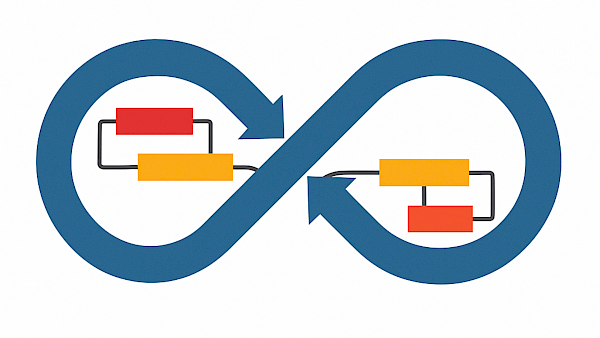Episode transcript The transcript is generated automatically by Podscribe, Sonix, Otter and other electronic transcription services.
Hello everyone, here is Ricardo Vargas, and this is the 5 Minutes Podcast. Today I want to talk about a topic that seems simple but often appears in complex project schedules, the activity loop, when one task becomes both a predecessor and a successor of another one. An activity loop happens when the sequence of dependencies forms a cycle. For example, activity A depends on B. B depends on C, and C depends on A. This creates a closed circuit that scheduling software most of the time cannot calculate because the logical model becomes undefined. Who starts first? Who finishes last? So, in theory, schedules should be linear, no returns, no cycles. But in practice, in real life, especially in engineering, product development, or innovation projects, the work and the reality of work are iterative. Teams engage in dialogue, they exchange information, they review each other’s deliverables, they adjust, and they go through the feedback cycles. That is what naturally creates these loops. So, a loop is not necessarily an error. It often represents a real aspect of how the process works. The problem arises when we try to represent this iterative behavior using tools designed for linear logic. The first recommendation I want to share with you is not about trying to avoid the cycle, but trying to think about how we can represent the cycle in a different way. For example, we can represent the iterative behavior in a structured way. For example, if a technical drawing will go through multiple reviews, instead of linking the review and adjustment tasks in a circular chain, you can separate and create versions, such as draft one, review of draft one, draft two, review of draft two, until you reach the final version. In this way, you preserve the sequence flow while still acknowledging interaction. Another good approach is to use intermediate milestones. I love milestones. You can create a review milestone where all the related activities converge to these intermediate milestones, and then they start this milestone, and release the start of the next group of tasks after that point. This breaks the cycle and keeps your logic consistent. Also, when two activities happen in parallel and influence each other but do not have a strict dependency, you can model it as a start-to-start relationship with lags. This shows overlapping without creating a closed loop. But what happens when the process is so highly interdependent that any of the options I mentioned before is possible? So, you need to create and represent it in a different way. Then it's time to think about a different way of modeling your approach. And maybe you should use the DSM or Design Structure Matrix. A DSM, I recorded several videos on my YouTube channel about DSM, which helps you map all dependencies among tasks, including the circular ones, because it's a matrix. So, you can show the relationship between A&B on both sides, A to B and B to A. So, you can have all these cycles very easily represented when you use a DSM. It allows you to define and identify clusters or interrelated activities, and you can plan them as a block rather than forcing them into a linear schedule. So, in short, whenever possible, remove the loops and represent these loops in a linear way, using versions, milestones, and controlled overlaps. But when loops are inherent to the nature of your work, and it's impossible to do that, recognize them and use models like DSM. So instead of representing the project using a Gantt chart, you can represent the same project using DSM to understand, optimize, and manage these interdependencies in a conscious way. After all, what is important, a schedule is just a model of reality. And reality, in many cases, is iterative. The project manager's role is to choose the right model for the right type of process. Think about that. I hope you enjoyed this episode. Sorry if it was a little bit more technical, but this is a topic that us as project managers must keep in mind and must be prepared to handle. I hope you enjoyed this. See you next week with another 5 Minutes Podcast!

